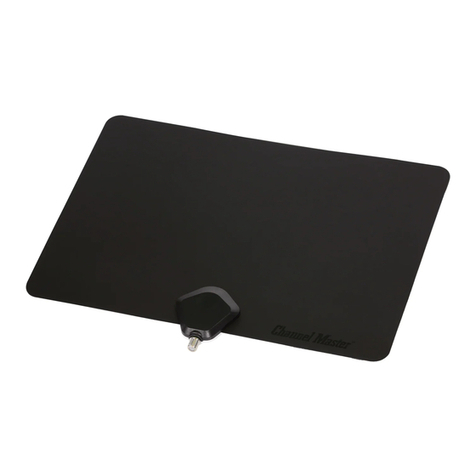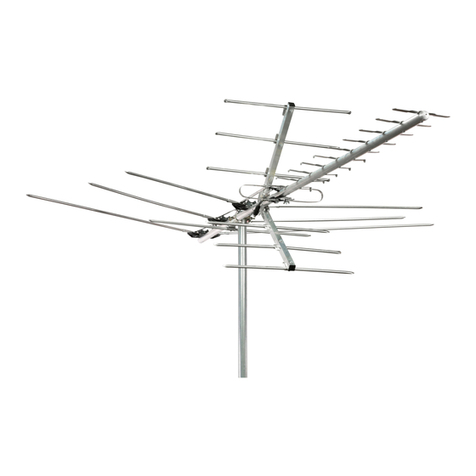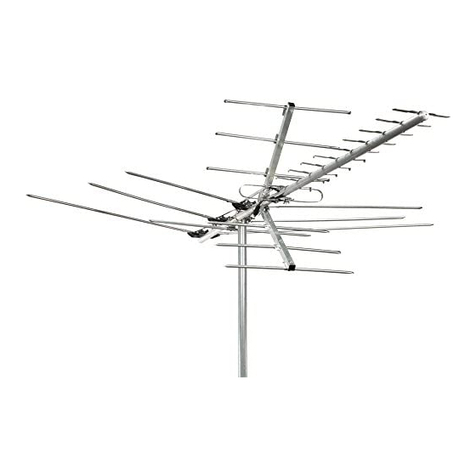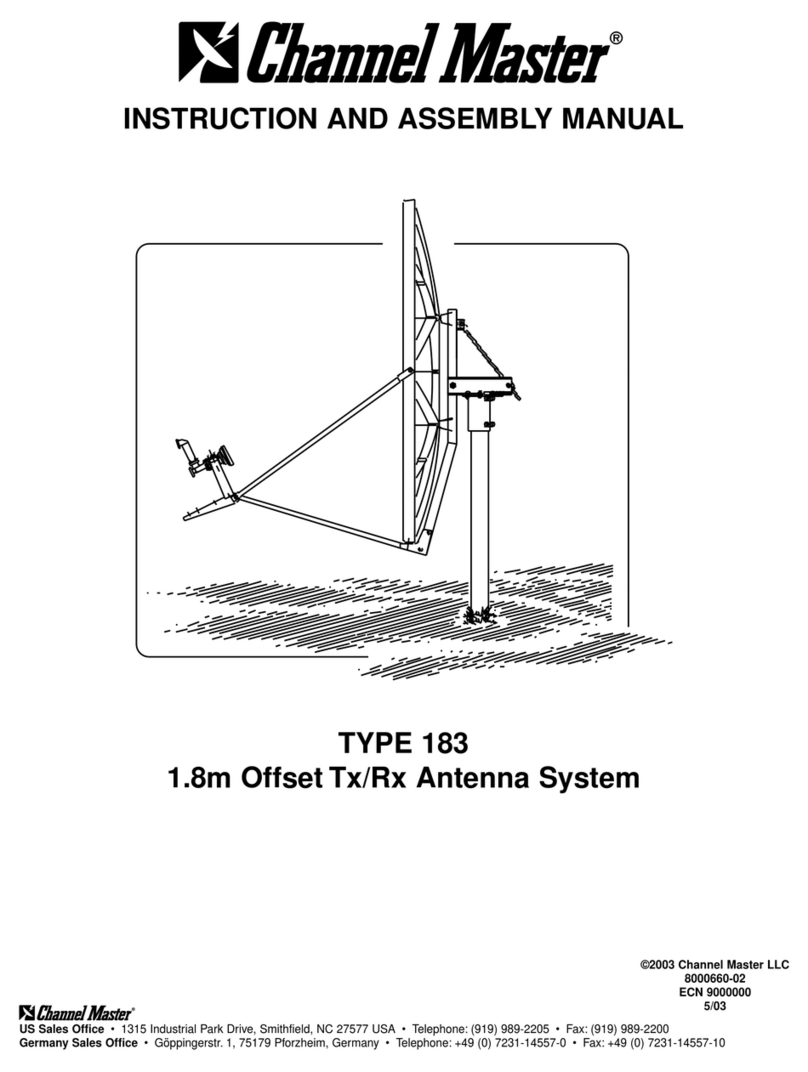
Before you start installation, let
us
worn you of the
danger
of
letting only part of your antenna system
touch electrical power lines - -
you
may
be killed.
Installation
dangerous.
directions.
WARNING!
of
this product near power lines is
For your safety, follow the installation
FOR THE SAFEST INSTALLATION,
FOLLOW THESE PROCEDURES
1.
Perform as much antenna assembly on the ground as possible.
2.
Watch out for overhead power lines. Check the distance
to
the power lines before you start
installing.
WE
RECOMMEND YOU STAYAMINIMUM OF TWICE
THE
MAXIMUM LENGTH
OF
THE
ANTENNA
ASSEMBLYAWAY FROM
ALL
POWER
LINES.
3.
Do
not use ametal ladder.
4. Remember, even the slightest touch
of
an antenna to apower line can cause afatal shock.
5. Do
NOT
try to do the job on awindy day.
6. Have afriend as aspotter when you're on the roof. They can see things you can't.
7.
If
you start to drop an antenna, move away from it and let it fall.
8. If any part
of
the antenna should come into contact with apower line CALL YOUR LOCAL
POWER COMPANY! DO
NOT
TRY TO REMOVE IT YOURSELF! They wil remove it safely.
9. Mast, lead-in, and metal
guy
wires are excellent conductors
of
electrical current - - keep them
away from powerlines too.
10. Be sure your family and friends understand the danger
of
touching an overhead power line.
Tell them never to try to remove
any
object in contact with apower line - -
ca,
TV
antenna,
or
anything else.
11.
Make sure that the antenna mast assembly is properly grounded.
IF AN ACCIDENT SHOULD OCCUR WITH THE POWER LINES:
It happens more often than you realize! Someone
falls off
of
aroof
or
gets the shock oftheir life.
Unfortunately, agood antenna site is often near
electrical power lines. If only metal antenna port
touches apowerline, it completes
on
electrical path
through the installer (that's you).
IADVERTENCIA!
•
La
instalaci6n
de
este producto cerca de cables de
alta tensi6n
es
peligrosa. Para
su
seguridad, siga las
instrucciones de instalaci6n.
Ante decomenzarla instalaci6n, permftanosadvertirle
acerca del peligro de que
el
sistema de la antena
entre
en
contacto con cables de alta tensi6n - -
ya que
pod
ria
ocasionarle
la muerte.
iOcurre mas frecuentemente de
10
que usted cree!
Alguien cae de un techo 0recibe una tremenda
descarga.
Lamentablemente, un buen lugar para la instalaci6n
de una antena amenudo
se
encuentracerca decables
de alta tensi6n.
Si
alguna parte metalica de
la
antena
entra
en
contacto con
un
cable de alta tensi6n, se
com
pi
eta
el
recorrido electrico atraves del instalador
(es decir, usted).
a.
Do
NOT grab hold
of
aperson
in
contact with the antenna and power line. You will be
in
danger and
SUbject to shocking and sever dangerL
b.
Use aDRY board, stick, or rope to push or pull the antenna away from the victim.
c.
Ifthe victim has stopped breathing, and it is safe to approach, administer artificial respiration and stay with
that person.
d.
Have someone call for medical help.
Recommended
by
the National ConsumerProduct Safety Council.
IMPORTANT GUIDELINES
FOR
INSTALLING ANTENNASI
If
you're not sure about careful, safe installation -do
NOT
try to do it yourself. Call for professional
help (look up Television Antenna Systems in your area
or
call your local power company).
Measure the maximum length
of
the antenna and mast assembly and then stay at least twice that
distance away from power lines. (If you don't have at least this much space, hire aprofessional to
do
the installation.)
When using amast for support, use only 11/4 in. diameter
or
largerantenna mast sections.
lengths
over 10 feet should be guyed at least each 10 foot section
PARA
LA
INSTALACION
mas
SEGURA,
SIGA ESTOS PROCEDIMIENTOS
1.
Realice
la
mayor parte de las taraas de montaje de
la
antena en
el
piso.
2.
Cuidese de los cables allreos de alta tensi6n. Verifique
la
distancia que
10
separa de los cables de alta tensi6n
antes de iniciar la instalaci6n •LE RECOMENDAMOS QUE SE MANTENGAA
UNA
DI$TANCIAMINIMA DE
LOS CABLES DE ALTA TENSION
IGUALAL
DOBLE DEL LARGO DEL CONJUNTO DE
LAANTENA.
3. No utilice una escalera metAlica.
4. Recuerde que hasta et contacto rMS Ieve entre Is antena ylos cables de alta tensi6n pueden provocar un
descargo mortal.
5. No intente realizar esta tarea en un dia ventoso.
6. Cuentecon la presencia de otta
pe~
para
que
10
observe mientras 58 encuentra en eltecho. Esta persona
puede ver cosas que usted no ve.
7.
Si
la
antena comienza acaerse, alejese ydejela caer.
8.
$i
cualquier parte de
la
antena antra en contacto con un cable de alta tensi6n - - Comunfquese CON SU
Compania LOCAL DE ELECTRIClDAO,
JNO
INTENTE RETIRARLA USTED MISMOI Ellos
la
retirarfm de
manera segura.
9.
EI
m~sti1,
los cables de acornetida ylos cables metalicos de retenido son excelentes cooductores de la
corriente el6ctrica -mantengalos alejados de los cables
de
alta tensl6n.
10. Asegurese de que sus familiares yamigos compreooan eI peligro que implica tocar un cable aereo de alta
tensi6n. Oigales
que
nunca intenten retirar ningun objeto que 58 encuentre en contaclo cornun cable de alta
tensi6n - • una antena de CB, de
TV
0cualquier otro
e1emento.
11.
Asegurese de que el conjunto del
m~stil
de la antena cuente con una conexi6n atierra adecuada.
YEN
CASO
DE
QUE
OCURRA
UN
ACCIDENTE
CON
LOS
CABLES
DE
ALTA
TENSI6N:
a. No toque a
la
persona que se encuentra en contacto con la antena yel cable de alta tensi6n (Ie ocunira
10
mismo austed).
b.
Utilice una tabla, vara 0cuerda SECA para alejar la antena
de
la victims.
c. Si la victima ha dejado de respirar, administre respiraci6n artifk:ial ypermanezca asu lado.
d. Solicite asistencia medica
Recomendado
per
el
Consejo
Nacional
de
8eguridad
de
Productos para Coosumo.
PAUTAS IMPORTANTES PARA LAINSTALACI6N DE ANTENAS
SI
no esta seguro aceres de c6mo realizar una instalaci6n cuidadosa ysegura -no intente hacerlo usted mismo.
Solicite ayuda profesional (en las
p~ginas
Amarillas,
en
la
secci6n
de
Sistemas deAntenas
de
Televisi6n 0en su
compa/Ua de electricidad local).
Mida la Iongitud
m~xima
del conjunto
de
antena y
m~stil
yluego ahijese al menos el doble de esa distancia de k)S
cables de alta tensKm. (Si no cuenta con ese
espado,
contrate aun profesional para realizar Is tarea).
Para sostener el
m~stil,
utilice unicamente soportes para
rMstiles
de
antenas
de
un
diamelro
de
1
1/4
poIgadas
0
superior.
las
IongiIudes
superiores
a
10
pies
deben
aIrioslrarse
lXlfI
cables
aI
menos
<:ada
10
pies.














































